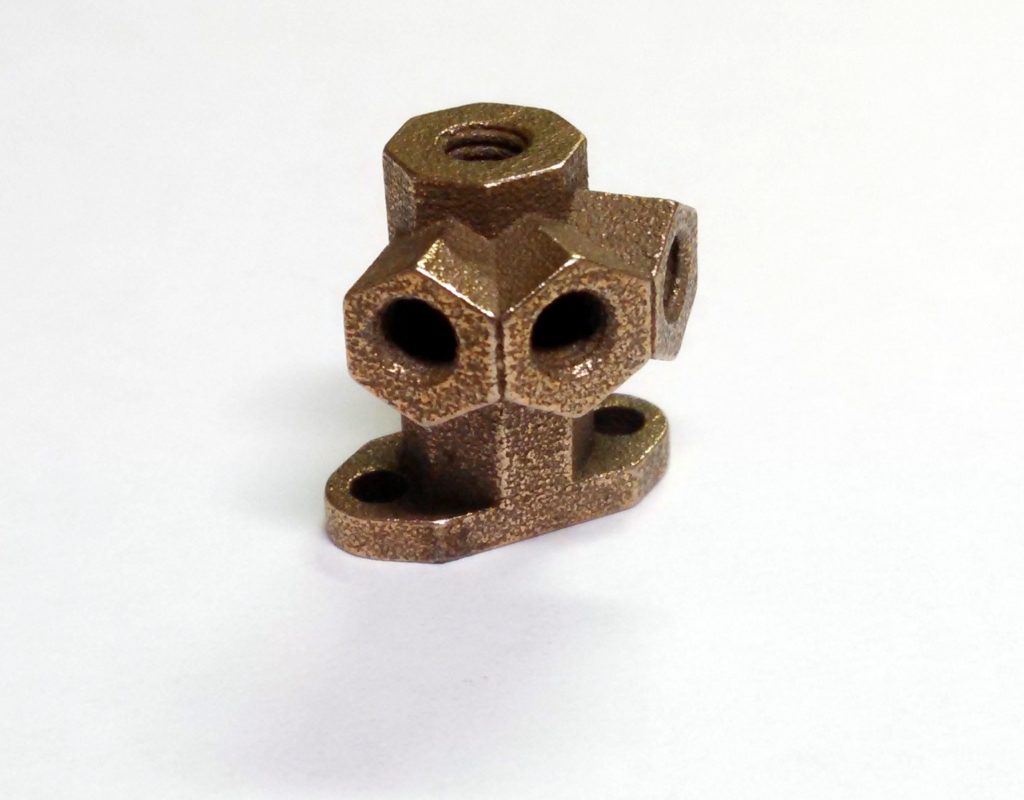Rockets are perfect for 3D printing technologies, well at least parts of rockets. Bodytubes, maybe not so much, control electronics, also a no, but rocket engines – there’s the ticket. They are relatively small parts with complex internal features and are manufactured in low quantity. Now for the bad news: they get very hot and very cold; they have small features; they are highly stressed. This means, in general, you can only use metal as a material. This limits us to DMLS, Casting and Infused metal.
DMLS is awesome; you send out a part as an stl file and you get a solid metal part back in a couple of weeks. While I have built various 3D printed parts, sadly none of them are mine to show, so instead check out this awesome work at Rocket Moonlighting. For rockets, DMLS materials are usually Inconel or PH 15-5 with other high temperature alloys such as Cobalt Chrome available as well as lightweight aluminum.
Infused metal is somewhat different from DMLS in that a porous version of the model is made, then infused with another alloy. Usually this is 420 SS fill with bronze. It is cheaper and quicker turn around than DMLS but at the expense of detail, only going down to around 40 mil holes vs DMLS 16 mil. Infused metal is also better with overhangs than DMLS. For these reasons, we are using Infused Metal for our igniter and injector, but if we were to make a regen engine we would probably use DMLS.

Casting is just like any other casting method, but it uses 3D printed wax. This technology has been around for decades now and is very common in low volume parts. It is a good technology, but it has a hard time dealing with long passages and thin walls, as well as only being commercially used with easy-to-cast alloys so we are not using it.
Rules of thumb:
If you can machine it, just machine it; it will probably be better, cheaper, and most likely faster.
Infused metal seems to build up more than the stl; allow for a ~4 mil growth.
You will have to tap most threads and, frankly, the surface finish is much improved by taping.
O-rings work fine with any of the 3D printed parts.
On DMLS, limit overhangs to 45 degrees or live with added supports during build.
ASK YOUR VENDOR about what post machining / supports they are adding.
Have a build direction in mind when you design the model; it really helps.
Surface finish isn’t great on DMLS or infused.
Long small holes are much more likely to clog than short small holes.
Make sure you have flats for post machining or wrench tightening.
That’s about it; give it a shot. Nothing says I’m living in the future like 3D printed metal parts arriving in the mail.

I’m not sure where you’re getting your information, but good topic.
I needs to spend some time learning more or understanding more.
Thanks for magnificent info I was looking for this info for
my mission.
Yes! Finally something about online pharmacies.
Have you ever thought about adding a little bit more than just your
articles? I mean, what you say is important and
everything. However think of if you added some great images or videos to give your posts more, “pop”!
Your content is excellent but with pics and videos, this blog could certainly be one of
the most beneficial in its niche. Superb blog!
Great post. I was checking continuously this blog and I
am impressed! Very useful info particularly the last part :
) I care for such info a lot. I was looking for this certain information for a very long time.
Thank you and best of luck.
Medicine prescribing information. Brand names.
where can i get pregabalin without dr prescription in USA
Some about meds. Get information here.
cialis online without pres how to take cialis is there a generic cialis
cialis generico what is tadalafil what is better viagra or cialis
how to write a critical reflection essay coming to america college essay how to write a closing sentence for an essay
300 word essay on community service writing narrative essays ielts essay on community service
viagra over the counter walmart viagra triangle chicago viagra government funded
buy generic 100mg viagra online viagra generico viagra pill
cv cover letter rn resume cover letter resume library
does cialis keep you hard after coming order cialis online buy cialis canadian
video resume create my resume minimalist resume
viagra without a prescription hims sildenafil sildenafil for dogs
sildenafil cost viagra walgreens alternative to viagra
cialis generic best price tadalafil price cialis dosage 20mg
cialis 40 mg discount cialis does daily cialis lower blood pressure
It’s a pity you don’t have a donate button! I’d without
a doubt donate to this superb blog! I suppose for now i’ll settle for bookmarking and adding your RSS feed to my Google
account. I look forward to brand new updates and will talk about this blog with my Facebook group.
Talk soon!
Hey I know this is off topic but I was wondering if you knew of
any widgets I could add to my blog that automatically tweet my newest twitter updates.
I’ve been looking for a plug-in like this for quite some time
and was hoping maybe you would have some experience with something like
this. Please let me know if you run into anything.
I truly enjoy reading your blog and I look forward to your new updates.
You actually make it appear really easy with your presentation however I to find this topic to be really something that I believe I’d never understand.
It sort of feels too complicated and extremely large for me.
I’m having a look forward for your next submit, I will attempt to get the grasp of it!
free essay writing service cheapest 4 hours help writing a thesis statement using an essay writing service reddit